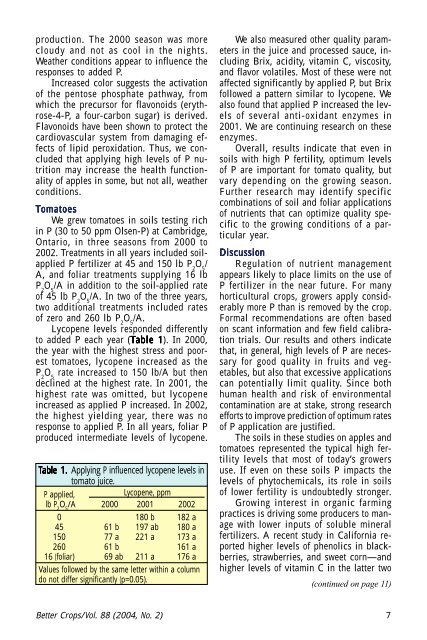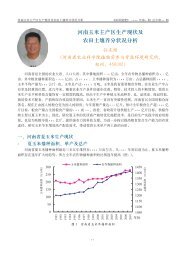Better Crops 2004 #2 - International Plant Nutrition Institute
Better Crops 2004 #2 - International Plant Nutrition Institute
Better Crops 2004 #2 - International Plant Nutrition Institute
Create successful ePaper yourself
Turn your PDF publications into a flip-book with our unique Google optimized e-Paper software.
production. The 2000 season was more<br />
cloudy and not as cool in the nights.<br />
Weather conditions appear to influence the<br />
responses to added P.<br />
Increased color suggests the activation<br />
of the pentose phosphate pathway, from<br />
which the precursor for flavonoids (erythrose-4-P,<br />
a four-carbon sugar) is derived.<br />
Flavonoids have been shown to protect the<br />
cardiovascular system from damaging effects<br />
of lipid peroxidation. Thus, we concluded<br />
that applying high levels of P nutrition<br />
may increase the health functionality<br />
of apples in some, but not all, weather<br />
conditions.<br />
Tomatoes<br />
We grew tomatoes in soils testing rich<br />
in P (30 to 50 ppm Olsen-P) at Cambridge,<br />
Ontario, in three seasons from 2000 to<br />
2002. Treatments in all years included soilapplied<br />
P fertilizer at 45 and 150 lb P 2<br />
O 5<br />
/<br />
A, and foliar treatments supplying 16 lb<br />
P 2<br />
O 5<br />
/A in addition to the soil-applied rate<br />
of 45 lb P 2<br />
O 5<br />
/A. In two of the three years,<br />
two additional treatments included rates<br />
of zero and 260 lb P 2<br />
O 5<br />
/A.<br />
Lycopene levels responded differently<br />
to added P each year (Table 1). In 2000,<br />
the year with the highest stress and poorest<br />
tomatoes, lycopene increased as the<br />
P 2<br />
O 5<br />
rate increased to 150 lb/A but then<br />
declined at the highest rate. In 2001, the<br />
highest rate was omitted, but lycopene<br />
increased as applied P increased. In 2002,<br />
the highest yielding year, there was no<br />
response to applied P. In all years, foliar P<br />
produced intermediate levels of lycopene.<br />
Table 1. Applying P influenced lycopene levels in<br />
tomato juice.<br />
P applied,<br />
Lycopene, ppm<br />
lb P 2<br />
O 5<br />
/A 2000 2001 2002<br />
0 180 b 182 a<br />
45 61 b 197 ab 180 a<br />
150 77 a 221 a 173 a<br />
260 61 b 161 a<br />
16 (foliar) 69 ab 211 a 176 a<br />
Values followed by the same letter within a column<br />
do not differ significantly (p=0.05).<br />
We also measured other quality parameters<br />
in the juice and processed sauce, including<br />
Brix, acidity, vitamin C, viscosity,<br />
and flavor volatiles. Most of these were not<br />
affected significantly by applied P, but Brix<br />
followed a pattern similar to lycopene. We<br />
also found that applied P increased the levels<br />
of several anti-oxidant enzymes in<br />
2001. We are continuing research on these<br />
enzymes.<br />
Overall, results indicate that even in<br />
soils with high P fertility, optimum levels<br />
of P are important for tomato quality, but<br />
vary depending on the growing season.<br />
Further research may identify specific<br />
combinations of soil and foliar applications<br />
of nutrients that can optimize quality specific<br />
to the growing conditions of a particular<br />
year.<br />
Discussion<br />
Regulation of nutrient management<br />
appears likely to place limits on the use of<br />
P fertilizer in the near future. For many<br />
horticultural crops, growers apply considerably<br />
more P than is removed by the crop.<br />
Formal recommendations are often based<br />
on scant information and few field calibration<br />
trials. Our results and others indicate<br />
that, in general, high levels of P are necessary<br />
for good quality in fruits and vegetables,<br />
but also that excessive applications<br />
can potentially limit quality. Since both<br />
human health and risk of environmental<br />
contamination are at stake, strong research<br />
efforts to improve prediction of optimum rates<br />
of P application are justified.<br />
The soils in these studies on apples and<br />
tomatoes represented the typical high fertility<br />
levels that most of today’s growers<br />
use. If even on these soils P impacts the<br />
levels of phytochemicals, its role in soils<br />
of lower fertility is undoubtedly stronger.<br />
Growing interest in organic farming<br />
practices is driving some producers to manage<br />
with lower inputs of soluble mineral<br />
fertilizers. A recent study in California reported<br />
higher levels of phenolics in blackberries,<br />
strawberries, and sweet corn—and<br />
higher levels of vitamin C in the latter two<br />
(continued on page 11)<br />
<strong>Better</strong> <strong>Crops</strong>/Vol. 88 (<strong>2004</strong>, No. 2) 7

















